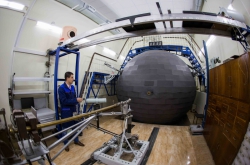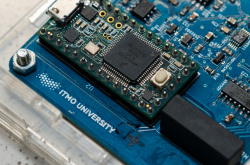Singlet oxygen is a specific active form of common oxygen that has more molecular energy. Thus, singlet oxygen is more active in redox reactions. In a human organism, it regulates cellular activity and has effect on immune reactions; singlet oxygen is widely used in medicine.
"Singlet oxygen can be formed as a result of photocatalytic processes: the matter absorbs light, transfers the energy to common triplet oxygen, and it becomes singlet. The amount of singlet oxygen in the atmosphere is low, yet, it can be part of different reactions. For instance, singlet oxygen destroys the ground-level (smog) ozone, which is a first class toxic substance. Singlet oxygen concentration is closely related to weather conditions and can be affected by many factors, so it is necessary to not only conduct pinpoint measurements, but study the system's dynamics, as well".

To solve this task, the student developed a new optical solid-body sensor, which was used to construct a special gas analyzer. The analyzer can be used to monitor singlet oxygen concentration in real-time.
"We detect singlet oxygen by means of the so-called selective reaction. To do this, we apply rubrene — a polyaromatic organic compound — to the sensor; when rubrene interacts with singlet oxygen, light energy is emitted. The light's intensity is in proportion to the amount of singlet oxygen", shares the scientist. "We've used the device to measure singlet oxygen concentration under different conditions, and found out that there's more singlet oxygen in winter. It turned out that singlet oxygen is actively formed on ice particles when it’s sunny. And as it has a positive effect on one's immunity, one can say that taking walks on cold sunny days is beneficial to one's health".

Even though only a small portion of ultraviolet radiation comes through the atmosphere, using the new device showed that it can intensify singlet oxygen formation even on the Earth's surface. According to Egor Yasenko, this leads to another interesting conclusion:
"This reaction is likely to be a lot more intensive in the higher layers of the atmosphere, which means that singlet oxygen also plays its role in destroying the ozone layer. Thus, ozone holes are not necessarily man-induced. It is known, for instance, that polar stratospheric clouds consisting of ice particles that form above Earth's magnetic poles affect the buildup of ozone holes in polar areas", adds the research student.
Egor Yasenko's research was highly appreciated by the Committee on Science and Higher Education of Saint Petersburg. In 2016, he became one of the winners of the "Environmental Protection. Human Ecology" contest.





